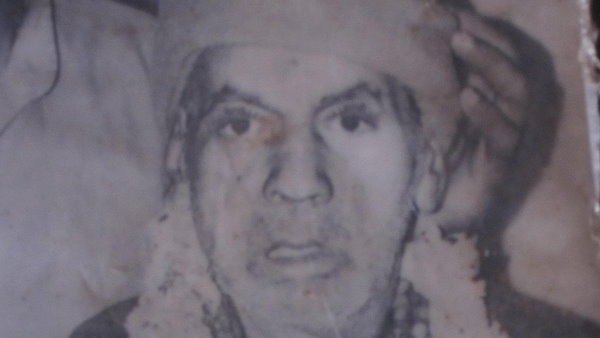- The Bihari sadhu who changed the Ayodhya discourse
- He is credited to have placed the idol of Ram lalla inside the Masjid in 1949
Abhyansh Singh Rathore
The saga of Ayodhya, entwined with the complexities of faith, history, and identity, holds within its folds the remarkable tale of Abhiram Das. A charismatic sadhu, Abhiram Das, significantly altered the discourse surrounding the Ram Janmabhoomi in Ayodhya. His role in placing the idol of Ram Lalla inside the central dome of the Babri Masjid in December 1949 proved to be a pivotal moment, setting in motion events that would shape the trajectory of the Ram Janmabhoomi campaign for decades.
The historical roots of the Ayodhya dispute delve into the 17th and 18th centuries when some fervent sadhus initiated campaigns for the restoration of the “Janmasthaan” – the sacred birthplace of Lord Ram. It was during this period that a medieval-era map, titled “Ayodhya Fort and Town,” gained prominence. This map, preserved at Jaipur’s City Palace Museum, became a visual testament to the contested terrain.
Moving forward in time, the mid-19th century saw sadhus in Faizabad actively petitioning local authorities for the restoration of the Janmasthaan. A significant turning point occurred in 1949 when a verdict declared Hindus, Muslims, and the Nirmohi Akhara as joint title holders of the contested site. However, the prevailing social environment was far from conducive to harmonious coexistence, marred by the communal aftermath of the violent partition of the country.
Amidst the charged atmosphere of post-partition Ayodhya emerged Abhiram Das, a dynamic and assertive sadhu whose presence would leave an indelible mark on the region’s history. Hailing from the Darbhanga district of Bihar, Abhiram Das was not only known for his muscular build but also for his haughty nature and short temper. Wrestling his way into the akhadas of Ayodhya, he became a prominent figure, with Lord Ram as the focal point of his religious identity.
Abhiram Das, surrounded by a small band of disciples, claimed to have experienced a divine dream wherein Lord Ram revealed the precise location of his birth – directly beneath the central dome of the Babri Masjid. This dream, seemingly guided by divine intervention, would prove to be the catalyst for a series of events that would reshape Ayodhya’s destiny.
Abhiram Das confided in Faizabad city magistrate Guru Dutt Singh, a fellow devotee of Lord Ram. Astonishingly, Singh shared a similar dream, solidifying the belief that divine forces were at play. With the support of district collector and magistrate KK Nayar, Abhiram Das orchestrated the placing of the idol of Ram Lalla inside the central dome of the Babri Masjid in 1949.
This strategic act, executed by Abhiram Das and supported by key officials, marked the inception of a new chapter in Ayodhya’s history. The placement of the Ram Lalla idol, allegedly with RSS involvement, laid the foundation for the Ram Mandir at the site eventually named Ram Janmabhoomi Sthal. This incident served as a precursor to an aggressive campaign in the 1980s and early 1990s by the RSS-BJP-VHP combine for the construction of the temple.
To fully comprehend the events leading to the construction of the Ram Mandir, one must delve into the political landscape of the time. The book, “Gita Press and the Making of Hindu India,” authored by journalist Akshaya Mukul, sheds light on the socio-political dynamics. Mukul credits Hindu assertion for the victory of Baba Raghav Das of the Congress in the Faizabad assembly by-election in 1948 over socialist candidate Acharya Narayan Dev. This period was marked by a communally charged environment, reflecting the sentiments prevailing in post-partition Ayodhya.
Abhiram Das, a muscular priest who had made Ayodhya his home, was not merely a spiritual figure but also a social influencer with connections to top district officials. His reputation as a wrestler-sadhu added a unique dimension to his persona, making him a charismatic and formidable presence in Ayodhya’s social circles. Despite his seemingly contentious nature, Abhiram Das played a pivotal role in shaping the narrative surrounding the Ram Janmabhoomi.
The narrative of the placing of the Ram Lalla idol inside the central dome of the Babri Masjid takes an intriguing turn with the alleged involvement of the Rashtriya Swayamsevak Sangh (RSS). According to the book, RSS leader Nanaji Deshmukh suggested that “the idol had been introduced into the Ayodhya complex after holy immersion in the Sarayu river under the leadership of [Hanuman Prasad] Poddar.” Poddar, a close aide and friend of the then Congress MLA Baba Raghav Das, adds a layer of complexity to the events, highlighting the intricate web of political affiliations.
The placing of the Ram Lalla idol inside the central dome set the stage for the fervent campaign that would follow in the coming decades. The opening of the locks of the premises by the Rajiv Gandhi government in 1986 further fueled the momentum. This act not only heightened the communal tensions but also reignited the debate surrounding the contested site, pushing it to the forefront of national consciousness.
The Gita Press, a prominent publisher of Hindu religious texts, played a significant role in shaping the narrative around Ayodhya. In his book, Akshaya Mukul explores the influence of the Gita Press on the making of Hindu India. The ideological alignment of the Gita Press with the sentiments of the time added fuel to the fire of the Ram Janmabhoomi campaign. The Gita Press’s role in disseminating literature that reinforced the cultural and religious identity of Hindus further fueled the fervor.
The Ram Mandir movement, spearheaded by the Rashtriya Swayamsevak Sangh (RSS), Bharatiya Janata Party (BJP), and Vishva Hindu Parishad (VHP), unfolded as a decades-long struggle marked by rallies, protests, and legal battles. The movement gained momentum through the 1980s and early 1990s, with the Ayodhya issue becoming a rallying point for the proponents of a Hindu Rashtra.
The culmination of the Ram Mandir movement took a dramatic turn on December 6, 1992, when the Babri Masjid was demolished by a frenzied mob. The events leading to the demolition and the subsequent aftermath remain controversial and continue to shape the socio-political landscape of India.
The legal battles surrounding the Ayodhya dispute were protracted and complex. The case went through various phases in the courts, involving multiple stakeholders with differing claims to the land. The eventual verdict by the Supreme Court of India in November 2019 granted the disputed land to Hindus for the construction of the Ram Mandir and allocated an alternative five-acre plot to Muslims for the construction of a mosque.
In reflecting on the intricate tapestry of Ayodhya’s history, Abhiram Das emerges as a central figure whose actions set in motion a chain of events that would ultimately reshape the spiritual and cultural landscape of the region. His dream, shared with Faizabad city magistrate Guru Dutt Singh, became a turning point, guiding the placement of the Ram Lalla idol and laying the foundation for the Ram Mandir.
The enigmatic sadhu who changed the Ayodhya discourse, is a testament to the complex interplay of faith, politics, and identity in India. His role in the placement of the Ram Lalla idol inside the Babri Masjid marked the beginning of a transformative journey that would span decades, culminating in the construction of the Ram Mandir. As Ayodhya continues to evolve, Abhiram Das remains a poignant figure, etched in the annals of history as a key architect of Ayodhya’s spiritual and cultural transformation.



